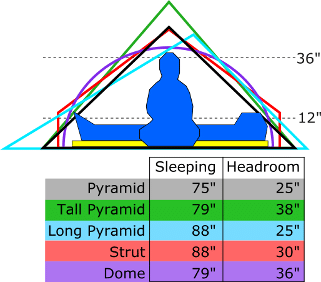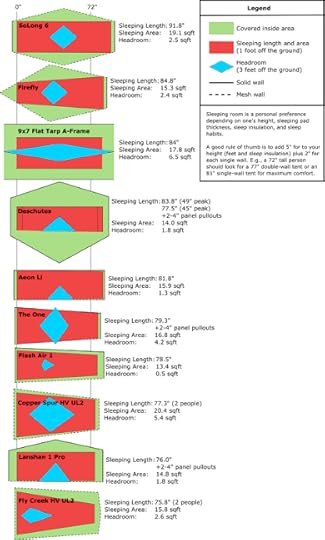Backpacking shelters for the BIG & tall, and those who sprawwwl
Backpacking tents and tarps are generally not designed for the big & tall and for those who love to sprawl. Many designs are cramped and claustrophobic for these users, which may hinder a night of quality sleep and lead to a soaking-wet sleeping bag from condensation-covered walls.
If this sounds like your nighttime experience, this article is for you. It will help you to find a new shelter that is sized properly for a backpacker with your dimensions and habits.
Very limited information is available about shelters for larger people. I’ll address this problem not with another list-icle (i.e. “10 Best Tents for Tall Backpackers in 2020”) but with a revolutionary new system for measuring the usable area of tents and fixed-shape tarps. Then, using this system I will offer standards for comfort and I will examine several popular models.
Key takeaways
This is a thoughtful post about an important topic, and the word count reflects that. Here are the main takeaways if you’re short on time:
There are very few tent options for hikers who are taller than 6’4”. If this is you:
The Lightheart Gear SoLong 6 could be your best tent option, but;Flat tarps with a bivy are infinitely customizable; and,Companies like Mountain Laurel Designs make a wide variety of pyramid tarps that are large enough to fit a circus elephant, and a tarp with a large inner net can be just as luxurious as a traditional tent.
There are many more options for people from 5’11” to 6’4”, and many traditional tents may even fit you depending on your sleeping habits. If you need more room then you might consider larger models like:
Lightheart Gear Firefly,SMD Skyscape Trekker, or Various designs from Tarptent that include struts and arched poles.
Proposal: A new standard for measuring tents
For a moment, imagine buying new pants without a waist or inseam (leg length) measurement. Instead, the pants are measured by their total length and by the square footage of the fabric.
With enough pants-buying experience, you may learn that you need pants that are three feet long and that are made with five square feet of fabric. But doesn’t that sound insane? Those measurements aren’t helpful, because they don’t really give you a sense of how they will fit YOU.
The same thing happens when buying a tent.
Today, tents are primarily measured and compared by their:
Peak height,Floor length and width, andFloor square area.
But just like the contrived pants measurements, these numbers are only loosely correlated with usable interior volume, which is the metric about which we really should care.
Three alternate measurements would be much more informative and revealing:
Sleeping length: The length across the sleeping area of the tent, measured one foot off the ground, which will be comfortable for a sleeper using an inflatable sleeping pad and a sleeping bag.Sleeping area: The total usable sleeping area created by the sleeping length and the width at the head and foot, all measured one foot off the ground. This forms a long trapezoid.Headroom: The available headroom while sitting, measured three feet off the ground, in a diamond shape.
Results
For measurements of popular tents, go HERE;For measurements of popular mids tarps, go HERE.
If a shelter you’d like to buy is not on one of these spreadsheets, let your favorite tent company know about this article. I’d be happy to measure their shelters, or they can adopt my new standard, which would save me a lot of work, and give them a leg up on this new system.
General case studies
Let’s look at some simplified examples to see how different tent shapes affect sleeping length and headroom. The diagram below shows a 6-foot tall person sitting up and laying down in a sleeping bag on a sleeping pad.

From this we can adopt some general rules:
Increasing the height primarily affects the headroom and has a smaller effect on the sleeping area.Increasing the length primarily affects the sleeping area and has a smaller effect on the headroom. Note that the long pyramid has a slightly lower peak than the pyramid but has the same headroom.Adding struts (or pitchloc’s) has the same effect as increasing the length while reducing the footprint.Adding a domed tent pole increases both the sleeping area and headroom and also reduces the footprint.
How much room do you need?
Follow this simple rule of thumb: Your sleeping area should equal your height plus five inches, to make room for your sleeping bag insulation and angled feet.
Several factors can affect this rule of thumb though:
If you sleep on a thick or a thin pad. Add 2-4” for a thick pad (4”) or subtract 2-4” if you use a thin pad (1”). Make larger adjustments for a tent with angled walls and less for a tent with steep walls.If you sleep in a single wall tent and want to avoid condensation. Add 2” for each single wall by your feet or head. Two at the most.If you sleep in a low-tension (droopy) inner net (does not apply to traditional double-wall tents where the inner net is high-tension). Subtract 3” since the netting will not compress your sleep insulation.If you are claustrophobic or toss and turn. Adjust accordingly!
NOTE: You can get away with a shorter sleeping length than this rule of thumb dictates. It is only a starting point that should work for most people.
Keep in mind that headroom is also largely a personal preference. Also, torso size can obviously vary between people of the same height. If you have a long torso then you will need more headroom than a person of a similar height but with a shorter torso. If you like to spend time in your tent after hiking, or if you plan to hike for several weeks or months, then you may also prefer having more headroom because it’s just more livable.
Real case studies
Now let’s look at measurements for a few tents pitched in the real world using this system. Hopefully, you’ve got some idea of where you fall due to personal experience with one or more of these models. Obviously, there is some variability between pitches of the same tent, but I estimate that the measurements are pretty accurate, more so for poled tents than tarps or mid-style shelters.
For a higher resolution diagrams, go here.


Summary and advice
Understand your personal needs. Look for a tent that accommodates your needs. Realize that your needs are unique to YOU.
AGAIN: Don’t let some random internet stranger convince you that you should feel comfortable in a tent that doesn’t fit you.
PERFECT EXAMPLE: My friend (and guinea pig for this article) is 6’7”. He sleeps in a Fly Creek UL2, even though he is way too big for it according to my new standard of measurement, but he has accepted the tradeoffs and is happy because it meets his needs. Meanwhile, I’m about 6’ and find that tent unbearable. Our needs are different, so it is not productive to argue about what size person fits in what size tent. It’s apples to oranges.
However, using my system we can objectively agree that a Copper Spur is roomier than a Fly Creek. Therefore you should look at the objective measurements in this article and determine what meets your specific needs.
Keep in mind this project is just getting started, but my goal is to set a new industry standard and I need your help! Let your favorite tent company know that there is a better way to help their customers choose a shelter that will reduce costly returns, increase profitability, and consumer satisfaction by referring them to this article. Everybody wins!
Thanks for reading, and happy trails.
Questions or thoughts? Leave a comment.
The post Backpacking shelters for the BIG & tall, and those who sprawwwl appeared first on Andrew Skurka.



